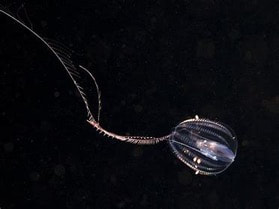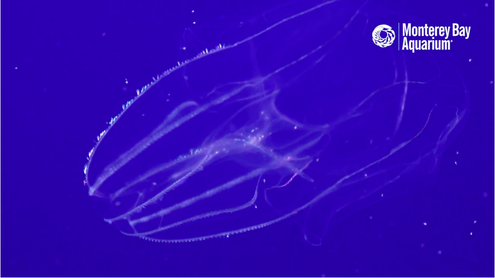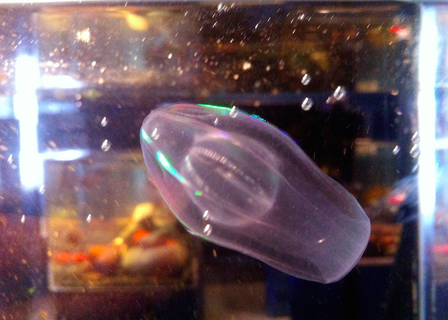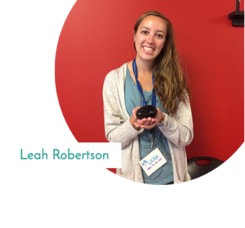|
by Leah Robertson “What are those jellyfish in the water?!” Every spring and early summer, Nova Scotia gets a group of fabulous visitors in our waters. I have seen so many people hanging their head over the side of the Halifax boardwalk trying to get a better look at these tiny mysteries. But today we are breaking the mystery for you. So what are they? They go by many names including ‘disco jellies’, ‘ctenes’, or ‘comb jellies’, but their mouthful of a scientific name is Ctenophora. [Pronounced “teen-OH-four-ah”]. Now these extravagant little jellies are many things but the one thing they are not is jellyfish! Sea Gooseberry Ctenophora (we have these in Nova Scotia too!) (photo: copyright Kare Telnes from seawater.no) While Ctenophora may have the gelatinous form we are used to seeing in ‘jellyfish’ (which is classified scientifically at Cnidiarians), there are a few hallmark reasons that make them their own phylum and a very fun animal to observe: Don’t fear! Ctenophora can’t sting you. This is one of the most noteworthy differences between Ctenophora and Cnidarians (aka jellfyfish!). They do not have what are called cnidocytes which deliver the stringing feeling we get when we touch the tentacles of a jellyfish. However, even though they can’t sting you we still recommend observing them at a safe distance. Since ctenophora have a soft jelly-like body it is very easy to injure these little wonders. How do they get around? I am so glad that you asked! Ctenphora are the largest organisms that move by ‘cilia’. Cilia are very tiny hairs that typically bacteria use to move around. Ctenophora have eight rows of the cilia attached to their body which move in tandem to help them get around. Slow and steady wins the race with ctenes! See how they move here. Lobed Comb Jelly (Photo: Monterey Bay Aquarium) Hey! Why do they look different? Both of these pictures are ctenophora, but are different species. Ctenophora really do come in all shapes and sizes. Ctenophora have lots of different species and some have beautiful long tentacles and some are nice and oval shaped without any additional appendages. Often in Nova Scotia, we have multiple different species of ctenohpora in our waters at the same time. What is the RAINBOW? Ctenophora are often mistaken are being “bioluminescent” which is the process where organisms give off their own light. Now some species of Ctenophora are biolumensect, but most often if you are seeing beautiful rainbow colours it is from the light refracting off the tiny beating cilia! We love to call them disco jellies for this reason! What do you think their favourite disco song is to synchronously move their rows of cilia to? (My bet is on Stayin’ Alive!). Ctenophore inside another ctenophore, ctenophore are sometimes eaten by larger fish, or larger ctenophores (photo: Magali Grégoire) They are CARNIVORES? Yes! While tiny and innocent looking, ctenophora do eat other animals (albeit animals tinier than them). They generally eat small zooplankton. But comb jellies themselves are often eaten by larger fish! You can watch this video to see them engulf food. So next time you see a comb jelly in the water, make sure you tell a friend all about these often-mistaken but amazing animals!
2 Comments
Tyson
6/11/2022 07:56:58 pm
I saw these for the first time this week! They are amazing to watch. I went online to search for answers to what I was looking at and found my good friend Leah with the knowledge bombs. :D Thanks!!
Reply
Leave a Reply. |
Categories
All
We send blog recaps with in all our quarterly newsletters!
|



